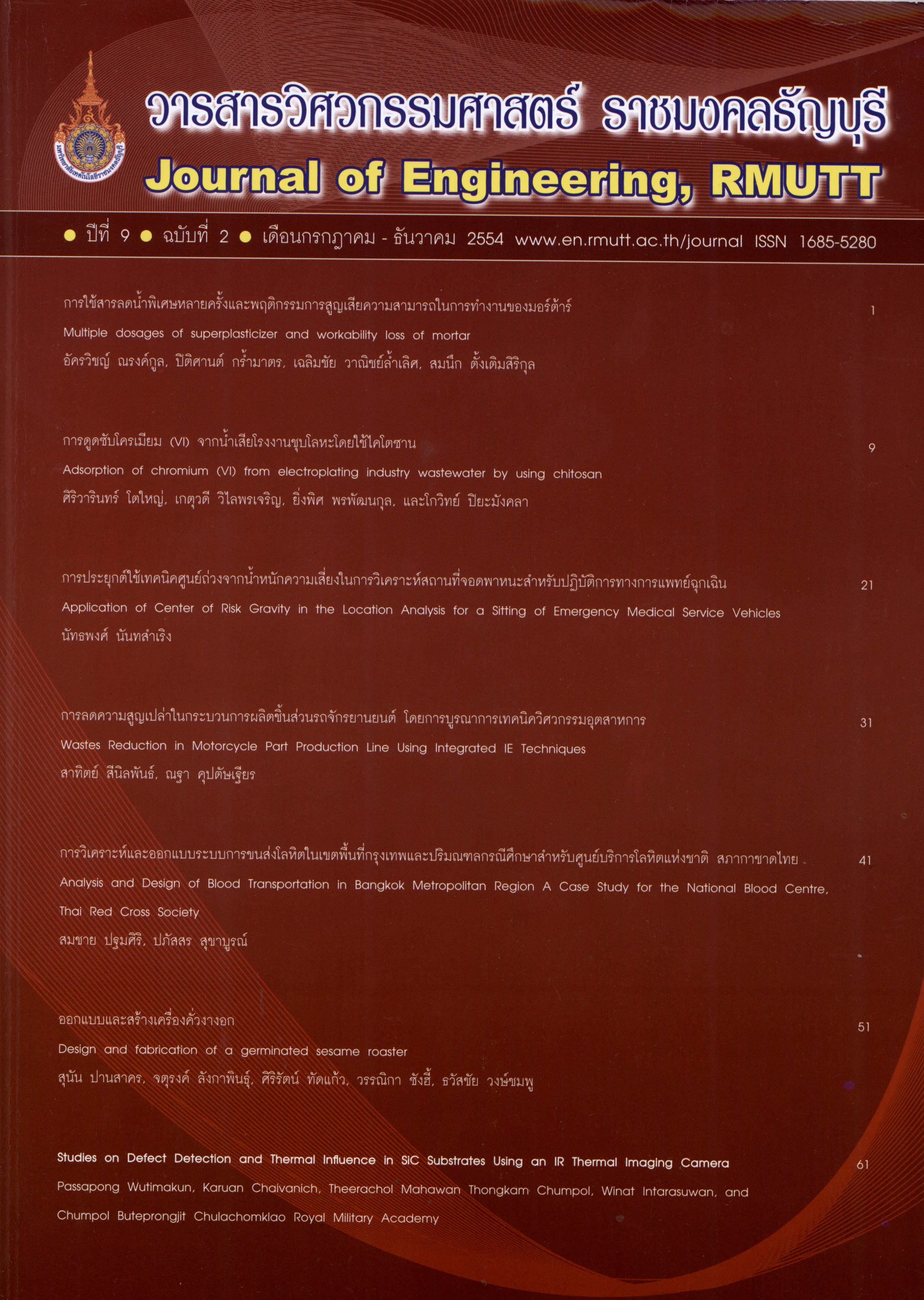Design and fabrication of a germinated sesame roaster
Main Article Content
Abstract
This research is to design and fabrication of a germinated sesame rotary roaster which has a capacity of 1 kg. The roaster is constructed using double wall cylindrical chamber and wrapped with rock wool. The outer dimensions of the roaster are 38.4 cm diameter and 35.5 cm length. Two 1000 Watt are using for the energy source and installed opposite of the rotary roaster. In addition, cylindrical material chamber is fabricated by stainless wire mesh of 0.5 mm diameter. Ideally, the roaster concept was prior estimated using conventional criterion based on pan roasting which is considering of the physical and nutrition properties of germinated sesame seed. The results are shown that, the roaster could be heated up over 100 degree Celsius and the temperature could be also controlled at steady state during roasting process. The rolling speed could be adjusted at the range of 1-21 rpm. It was noted that the best speed of the roasted geminated sesame was 16 rpm. Regarding the experiment at 100 degree Celsius of the roasting temperature, germinated sesame seeds provided a good quality and flavor. Besides, the moisture content and whiteness values were decreased with roasting time increased, while color value (a-value and b-value) and browning index (BI) of germinated sesame seeds were no difference. The trend of GABA content of germinated sesame seeds was declined with higher and longer of roasting temperature and time, respectively. However, the GABA content of the germinated sesame seeds was higher than sesame seeds without germination.
Article Details
The manuscript, information, content, picture and so forth which were published on Frontiers in engineering innovation research has been a copyright of this journal only. There is not allow anyone or any organize to duplicate all content or some document for unethical publication.
References
Kawabata, K., Tanaka, T, Murakami, T,, Okada, T,Murai, H., Yamamoto, T,, Hara,A., Shimizu.
M., Yamada, Y., Matsunaga, K., Kuno, T,Yoshimi, N., Sugie, S., and Mori, H. 1999.Dietary prevention of azoxymethane-induced colon carcinogenesis with rice-germ in F344 rats. Carcinogenesis (Lond.), 20: 2109-2115.
Komatsuzaki, N., Tsukahara, K., Toyoshima, H,Suzuki, T., Shimizu, N., and Kimura, T. 2003.
Effect of soaking and gaseous phase sprout processing on the GABA content of pregerminated brown rice. The American Society of Agricultural and Biological Engineer. Paper number: 036073.
Oh, S.H., Soh, J.R., and Cha, Y.S. 2003. Germinated brown rice extract shows a nutraceutical effect in the recovery of chronic alcohol—related symptoms. Journal Medicinal Food. 6:115-121.
Hemalatha, K.P.J. and Prasad, D.S. 2003. Changes in the metabolism of protein during germination of sesame (Sesamum indicum L.) seeds. Plant Foods for Human Nutrition. 58:1-10.
Anonymous. 1998. Sesame Seeds :http://homecooking.about.com/library/archivel
blspice18.htm
พิสิษฐ์ เตชะรุ่งไพศาล อริยากรณ์ พงษ์รัตน์. 2549.เครื่องสกัดน้ำมันงา วิศวกรรมสาร มข. ปีที่ 33
ฉบับที่รหน้ำร6ร-6 จำนวน 12 หน้า.
Sirato, Y.s,, Katsuta, M,, Okuyama, Y., Takahashi,Y, and Ide, T. 200 1. Effect of sesame seeds rich in sesamolin on fatty acid oxidation in rat liver.Journal Agricultural Food Chemistry. 49(5):
Ham, T.S, Park, S.J, and Lo, Y.M. 2009. Effects of germination on chemical composition and functional properties of sesame (Sesamum indicum L.) Seed. Bioresource Technology.
:1643-1647.
Kyauk, H., Hopper, N.W.and Brigham, R.D.1995.Effect of temperature and presoaking on
germination, root length and shoot length of sesame (Sesamum indicum L.). Environmental and Experimental Botany. 35(3): 345-351.
E1-Adaway, T.A., and Mansour, E.H. 2000.Nutritional and physicochemical evaluations
of tahina (sesame butter) prepared from heattreated sesame seeds. Journal of Science of Food and Agricultural. 80: 2005-2011.
AOAC. 1990. Official Methods of Analyses of the Association of Official Analytical Chemists. 15th ed. Association of Official Analytical Chemists.
Mustafa, A., Aman, P., Andersson, R., and Kamal,E.A. 2007. Analysis of free amino acid in cereal products, Food Chemistry. 105(1): 317-324.
Aralan, N,, and Togrul, H. 2005. Moisture sorption isotherms for crushed chillies. Biosystems Engineering. 90: 47-61.
Hussain,S.R., Terao, J,, and Mathuushita, S. 1986.Effect of browning products of phospholipids on autoxidation of methyly lioenets. Journal of American oil Chemist Society. 63:1457-1560.
Kahyaoglu, T., and Kaya, S. 2006. Modeling of moisture, color and texture changes in sesame seeds during the conventional roasting. Journal of Food Engineering, 75: 167-177.
Avila, I.M.L.B., and Silva, C.L.M. 1999. Modeling kinetics of thermal degradation of colour in peach puree. Journal of Food Engineering.39:161-166.
อริยาภรณ์ พงษ์รัตน์ และ พิสิษฐ์ เตชะรุ่งไพศาล.2552. เครื่องคั่วงา. วารสารวิจัย มหาวิทยาลัย
ขอนแก่น,มีนาคม 2552. 14(3): 275-282.


